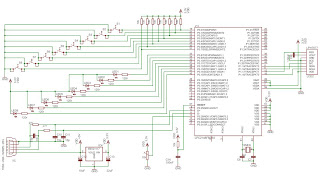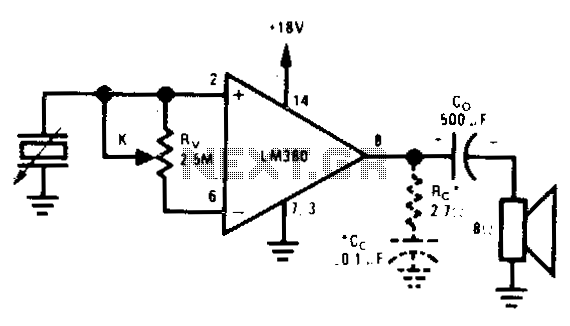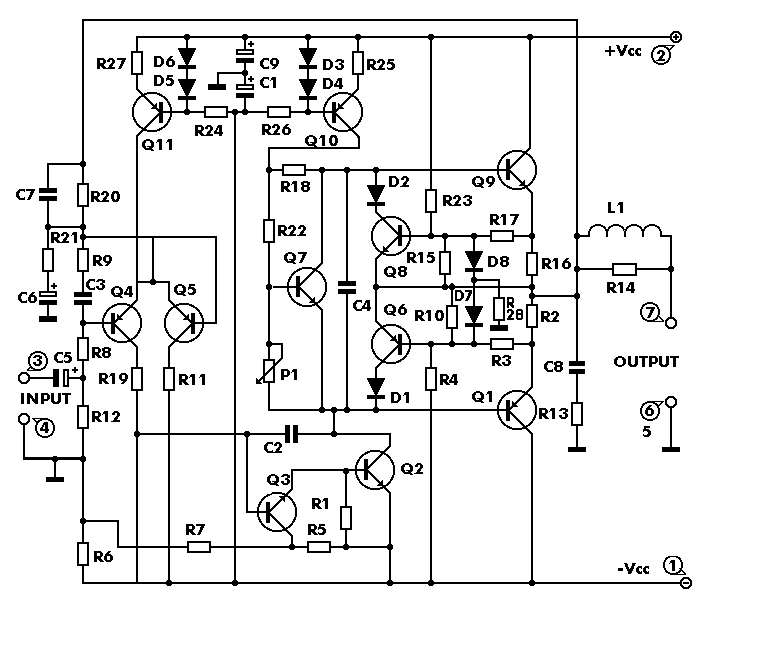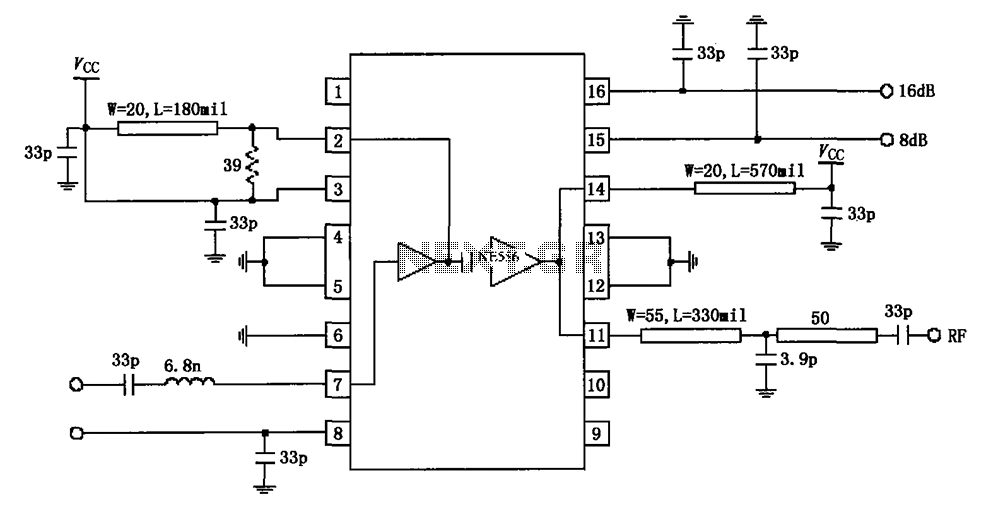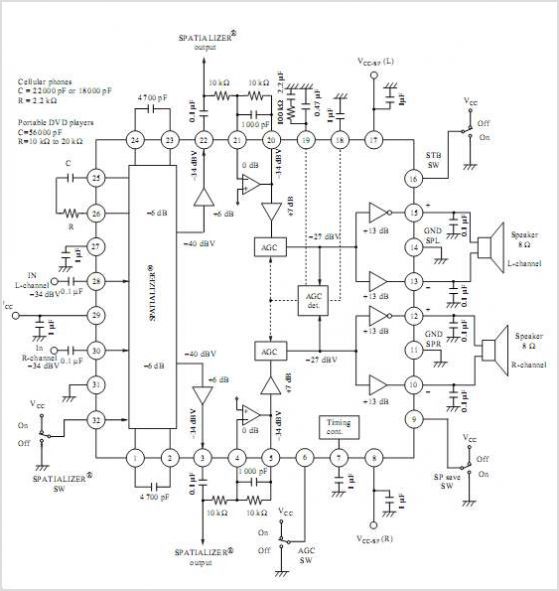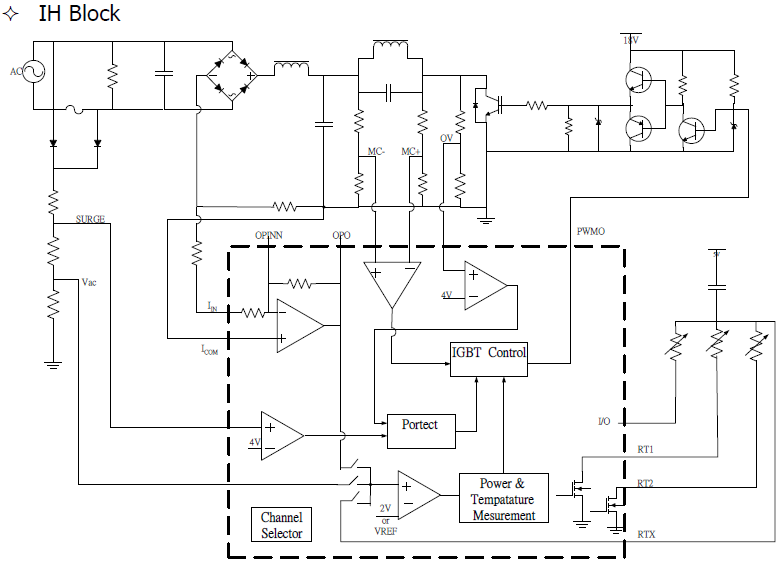
Condenser Mic Audio Amplifier
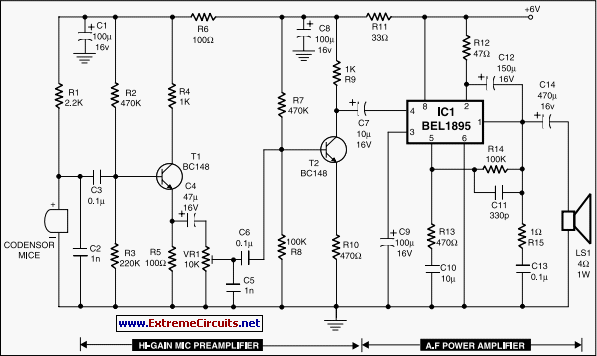
The compact, low-cost condenser microphone audio amplifier described here provides high-quality audio output of 0.5 watts at 4.5 volts. It can be utilized in intercom systems, walkie-talkies, low-power transmitters, and packet radio receivers. Transistors T1 and T2 constitute the microphone preamplifier. Resistor R1 supplies the necessary bias for the condenser microphone, while variable resistor VR1 serves as a gain control to adjust the amplifier's gain. To enhance audio power, the low-level audio output from the preamplifier stage is coupled through coupling capacitor C7 to the audio power amplifier, which is built around the BEL1895 integrated circuit (IC). The BEL1895 is a monolithic audio power amplifier IC designed specifically for sensitive AM radio applications, delivering 1 watt into a 4-ohm load at a 6V power supply voltage. It exhibits low distortion and noise, operating within a supply voltage range of 3V to 9V, making it ideal for battery-powered applications. A turn-on pop reduction circuit is included to prevent thumping sounds when the power supply is activated. Coupling capacitor C7 also influences the low-frequency response of the amplifier. Capacitor C9 functions as a ripple-rejection filter, while capacitor C13 couples the output available at pin 1 to the loudspeaker. The combination of resistor R15 and capacitor C13 serves as a damping circuit to mitigate output oscillations. Capacitor C12 provides a bootstrapping function. This circuit is suitable for low-power HAM radio transmitters, supplying the necessary audio power for modulation. With simple modifications, it can also be adapted for use in intercom circuits.
The described audio amplifier circuit utilizes a straightforward yet effective design, making it accessible for various applications in communication devices. The use of transistors T1 and T2 allows for efficient amplification of the audio signal from the condenser microphone, ensuring clarity and fidelity. The gain control provided by VR1 enables users to customize the output level according to specific needs, which is particularly beneficial in environments with varying background noise levels.
The BEL1895 IC, known for its reliability and performance in audio applications, is central to the circuit's functionality. Its capability to deliver 1 watt into a 4-ohm load ensures adequate power for driving small loudspeakers, making it suitable for handheld devices. The low distortion and noise characteristics are essential for maintaining audio quality, particularly in communication systems where clarity is paramount.
The circuit's design includes several capacitors that play critical roles in performance. Coupling capacitor C7 not only facilitates the transition of audio signals between stages but also shapes the frequency response, allowing for a tailored audio experience. Capacitor C9’s role as a ripple-rejection filter is vital for maintaining a clean power supply, thereby enhancing overall circuit stability. The damping circuit formed by R15 and C13 is crucial in preventing unwanted oscillations that could distort the audio output, ensuring a smooth and consistent sound.
Overall, this audio amplifier circuit is a versatile solution for low-power audio applications, particularly in the realm of amateur radio and communication devices. Its adaptability for intercom systems with minor adjustments further extends its utility, making it a valuable component in various electronic projects.The compact, low-cost condenser mic audio amplifier described here provides good-quality audio of 0. 5 watts at 4. 5 volts. It can be used as part of intercoms, walkie-talkies, low-power transmitters, and packet radio receivers. Transistors T1 and T2 form the mic preamplifier. Resistor R1 provides the necessary bias for the condenser mic while prese t VR1 functions as gain control for varying its gain. In order to increase the audio power, the low-level audio output from the preamplifier stage is coupled via coupling capacitor C7 to the audio power amplifier built around BEL1895 IC. BEL1895 is a monolithic audio power amplifier IC designed specifically for sensitive AM radio applications that delivers 1 watt into 4 ohms at 6V power supply voltage.
It exhibits low distortion and noise and operates over 3V-9V supply voltage, which makes it ideal for battery operation. A turn-on pop reduction circuit prevents thud when the power supply is switched on. Coupling capacitor C7 determines low-frequency response of the amplifier. Capacitor C9 acts as the ripple-rejection filter. Capacitor C13 couples the output available at pin 1 to the loudspeaker. R15-C13 combination acts as the damping circuit for output oscillations. Capacitor C12 provides the boot strapping function. This circuit is suitable for low-power HAM radio transmitters to supply the necessary audio power for modulation.
With simple modifications it can also be used in intercom circuits. 🔗 External reference
The described audio amplifier circuit utilizes a straightforward yet effective design, making it accessible for various applications in communication devices. The use of transistors T1 and T2 allows for efficient amplification of the audio signal from the condenser microphone, ensuring clarity and fidelity. The gain control provided by VR1 enables users to customize the output level according to specific needs, which is particularly beneficial in environments with varying background noise levels.
The BEL1895 IC, known for its reliability and performance in audio applications, is central to the circuit's functionality. Its capability to deliver 1 watt into a 4-ohm load ensures adequate power for driving small loudspeakers, making it suitable for handheld devices. The low distortion and noise characteristics are essential for maintaining audio quality, particularly in communication systems where clarity is paramount.
The circuit's design includes several capacitors that play critical roles in performance. Coupling capacitor C7 not only facilitates the transition of audio signals between stages but also shapes the frequency response, allowing for a tailored audio experience. Capacitor C9’s role as a ripple-rejection filter is vital for maintaining a clean power supply, thereby enhancing overall circuit stability. The damping circuit formed by R15 and C13 is crucial in preventing unwanted oscillations that could distort the audio output, ensuring a smooth and consistent sound.
Overall, this audio amplifier circuit is a versatile solution for low-power audio applications, particularly in the realm of amateur radio and communication devices. Its adaptability for intercom systems with minor adjustments further extends its utility, making it a valuable component in various electronic projects.The compact, low-cost condenser mic audio amplifier described here provides good-quality audio of 0. 5 watts at 4. 5 volts. It can be used as part of intercoms, walkie-talkies, low-power transmitters, and packet radio receivers. Transistors T1 and T2 form the mic preamplifier. Resistor R1 provides the necessary bias for the condenser mic while prese t VR1 functions as gain control for varying its gain. In order to increase the audio power, the low-level audio output from the preamplifier stage is coupled via coupling capacitor C7 to the audio power amplifier built around BEL1895 IC. BEL1895 is a monolithic audio power amplifier IC designed specifically for sensitive AM radio applications that delivers 1 watt into 4 ohms at 6V power supply voltage.
It exhibits low distortion and noise and operates over 3V-9V supply voltage, which makes it ideal for battery operation. A turn-on pop reduction circuit prevents thud when the power supply is switched on. Coupling capacitor C7 determines low-frequency response of the amplifier. Capacitor C9 acts as the ripple-rejection filter. Capacitor C13 couples the output available at pin 1 to the loudspeaker. R15-C13 combination acts as the damping circuit for output oscillations. Capacitor C12 provides the boot strapping function. This circuit is suitable for low-power HAM radio transmitters to supply the necessary audio power for modulation.
With simple modifications it can also be used in intercom circuits. 🔗 External reference
Warning: include(partials/cookie-banner.php): Failed to open stream: Permission denied in /var/www/html/nextgr/view-circuit.php on line 713
Warning: include(): Failed opening 'partials/cookie-banner.php' for inclusion (include_path='.:/usr/share/php') in /var/www/html/nextgr/view-circuit.php on line 713
